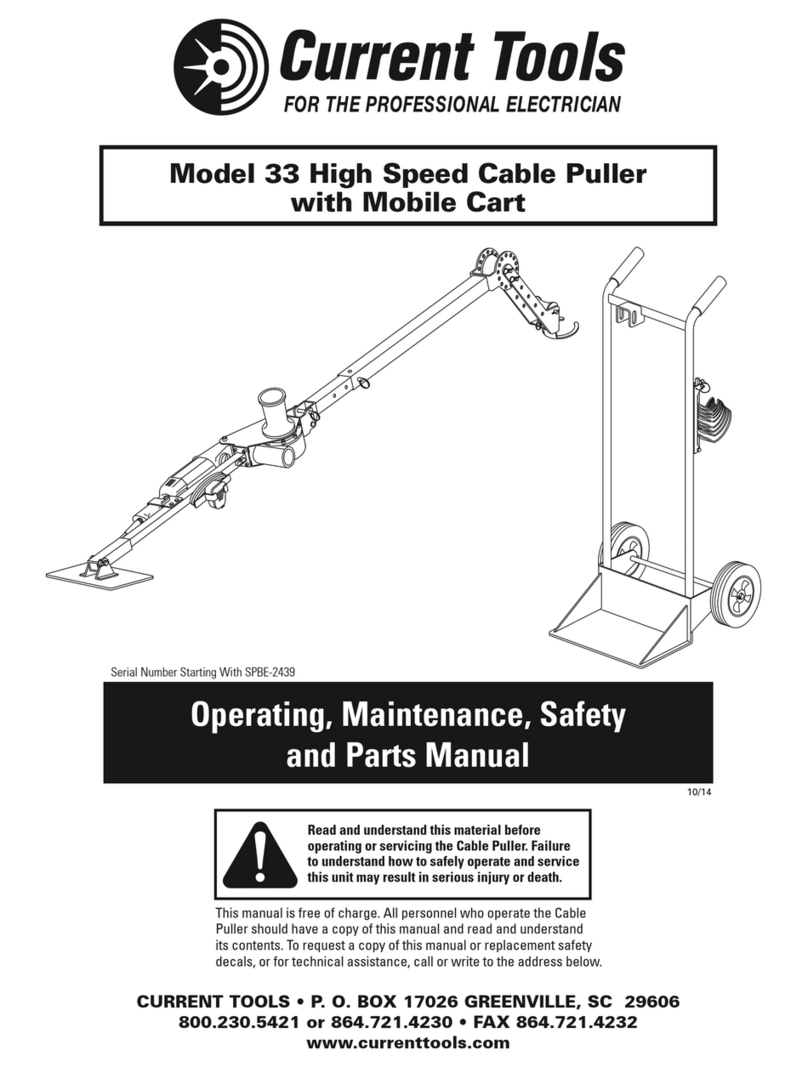
5
IMPORTANT SAFETY INFORMATION — CONTINUED
Pulling Rope should be the only thing to contact the capstan.
NEVER let swivels, grips, etc. come in contact with the capstan.
Keep as much rope confined in conduit as possible. This will help
prevent injury should the rope break and whip violently.
Rope must ALWAYS be pulled over a rotating sheave. If a sheave
does not rotate, turn cable puller off immediately and determine
problem before continuing the pull.
This cable puller is equipped with an anti-reversing pawl. The pawl
will make a clicking sound when the capstan is rotating. If you can
not hear the clicking sound as the capstan rotates, immediately turn
the cable puller off and do not use until repaired.
ONLY use 7/8” diameter or larger double-braided composite pulling
rope, or a pulling rope with a minimum average breaking strength
of 32,000 lbs.
NEVER allow the rope to slip on a rotating capstan for more than
a couple of seconds. The rope will wear in that spot and the rope
could break under pressure. If you need to stop the pull, turn the
cable puller off and tie the rope off to hold it in place until you
restart your pull.
Keep all body parts, hair, loose clothing, etc. away from rotating
parts and pinch points. Keep hands away from capstan.
NEVER allow the rope to overlap on the capstan. If this condition
begins to occur, immediately release the tailing force on the rope so
that the rope can feed back toward the conduit or cable tray. If this
does not remedy the overlap, turn off the cable puller immediately.
There is no known solution for rope overlap.
Some components of the mobile cable pulling package exceed 50
lbs. and will require more than one person to lift, transport and
assemble.
ALWAYS inspect pins to be sure they are the correct part number for
the assembly and are fully inserted through holes and have spring
clips property attached. DO NOT substitute any other object for
factory supplied pins.
The pulling rope must come in contact with ALL the sheaves used
in the boom system. This includes the elbow unit sheave when the
elbow unit is installed.
When making a vertical cable pull, keep the area underneath the
cable pull clear of all personnel.
ALWAYS ensure the factory supplied boom tubes are fully inserted
into the receiver tubes and that the spring loaded boom pins are
fully engaged in the boom tube holes. When using boom tubes
other than factory supplied, ensure they are fully inserted into the
receiver tubes (sight holes are provided to ensure tubes are fully
inserted) and 1/2-13 × 2" hex head cap screws (not provided) are
installed and tightened against the tubes. DO NOT transport the
puller on the carriage with boom tubes longer than the factory
supplied 3' and 4' tubes.
WARNING
WARNING
WARNING
WARNING
WARNING
WARNING
WARNING




























